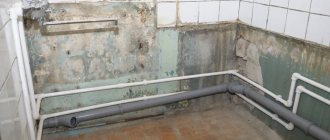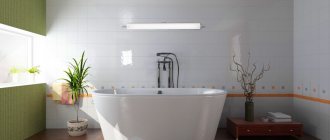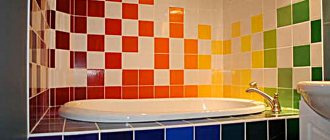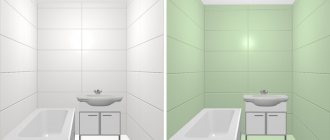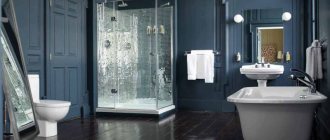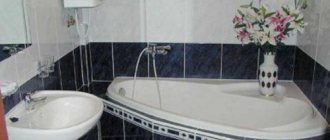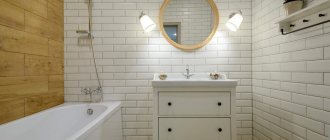When planning the design and renovation of a bathroom, one small but very important point should be taken into account - the problem of air exchange. Good ventilation in the bathroom and toilet is necessary not only to provide fresh air.
Using this system, unpleasant odors and excess moisture are removed from the bathroom. If the ventilation system is planned and implemented correctly, bathroom owners will not have to worry about mold and mildew.
The lack of normal ventilation and the excess humidity caused by this circumstance will create almost luxurious conditions for the development of harmful flora.
What should good ventilation be like?
Construction manuals clearly indicate the standards that must be followed for effective ventilation of sanitary premises with high humidity.
The system must provide fresh air for the bathroom or toilet at a speed of 25 cubic meters. m/hour, and for a combined unit twice as high - 50 cubic meters. m/hour. These standards are minimum.
Sometimes experts recommend removing air from the bathroom at a speed of about 150 cubic meters. m/hour.
Depending on the characteristics of air exchange, natural and forced ventilation are distinguished. In the first case, air exchange occurs due to the difference in air pressure outside and inside the room.
Air flows penetrate through windows, doors, special ventilators, etc. It is worth immediately noting that due to the nature of the bathroom design, the use of natural ventilation does not always achieve the desired effect.
To install ductless ventilation in the bathroom, it is necessary to make an opening that will connect the house ventilation duct with the bathroom room
When forced or artificially ventilating a room, special fans are used to ensure sufficient air exchange.
Most often, a fan helps move air from indoors to outdoors, while fresh air masses enter the bathroom from living quarters.
Sometimes a small fan is placed in the toilet, even with good natural ventilation, to speed up the purification of the air from unpleasant odors.
If it is not possible to naturally organize sufficiently intense air exchange, forced ventilation is mandatory.
Depending on the purpose there are:
- exhaust;
- supply;
- mixed ventilation.
The exhaust principle has already been described a little above: air is removed through the ventilation duct, and new air is supplied from the outside. Supply ventilation is organized differently: air is pumped in from the outside and forced out through the channel.
When using mixed ventilation, both the air flow and its removal are regulated.
A beautiful decorative grille for an exhaust hood in a bathroom will not only hide the structure, but can also become an effective detail of a stylish interior.
Experts also distinguish between duct and non-duct ventilation, which is characterized by the presence or absence of a ventilation duct.
Creating dedicated channels should be avoided whenever possible. Usually, an opening is made in the wall that opens into the common ventilation duct of a multi-story building, and a fan is installed in it.
In a separate bathroom, if there is access to the ventilation duct in only one room, another fan is installed in the wall opening between the bathroom and the toilet.
Installing a separate ventilation duct makes sense in places that require intensive removal of polluted or moisture-saturated air.
Advantages and features of forced ventilation systems
Before making ventilation in the bathroom, it is necessary to calculate the effectiveness of using a particular system in a separate case. This is most often necessary due to insufficient air exchange capacity provided by the supply and exhaust system. This device has more disadvantages than advantages. Therefore, air exchange should be increased.
Forced ventilation in the bathroom can correct the situation. Its installation process will not take much time if each room already has its own separate channel. You just need to get fans, which should be installed in the existing holes.
But sometimes such ventilation is developed before construction begins or in rooms where ventilation ducts have not previously been used.
If, in such conditions, there is a need to install forced ventilation in the bathroom or toilet with your own hands, then the process will drag on for a long time. In addition, what equipment is used for construction is no less important. An axial, duct or radial device (fan) is installed in the ventilation duct.
Diagnosis of ventilation status
Before you begin altering the ventilation in the toilet and bathroom, you should carefully study its structure and check its condition. To begin with, they examine the draft: a sheet of paper, a lit match or a lighter is brought to the ventilation hole.
If the paper sticks to the hole, or if the flame is clearly moving towards the ventilation duct, there is a draft. On a hot, windless day, the draft may be significantly less than at other times.
The presence of draft in itself does not always indicate the normal state of the ventilation system.
It is imperative to check the condition of the ventilation duct, which may be partially blocked after inept repair work or for some other reason.
By removing obstacles, you can significantly improve the quality of the ventilation system.
To check the draft in the bathroom, hold a sheet of paper or the flame of a lighter to the vent. The check should be carried out with the door open, and then with the door closed.
It is recommended to check the presence of draft first with the door and window open, and then with the fresh air sources tightly closed.
If in the latter case the draft has noticeably decreased, you should think about additional means of micro-ventilation.
Most often, it is enough to install special grilles in the doors of the bathroom and toilet to ensure normal flow of fresh air into these rooms even when the doors and windows are closed.
Causes of poor ventilation draft
Ventilation may not always work as required, and there can be plenty of reasons for this. Therefore, before you start arranging ventilation in the bathroom and toilet, it is worth considering all the important nuances, including the reasons for poor ventilation draft.
What reasons may cause poor ventilation:
- sometimes ventilation problems can occur due to errors in calculations in the cross-section of ventilation ducts;
- various errors when installing the ventilation system;
- Often, the pull can be caused by a build-up of debris, as well as other falling elements. The presence of all these elements can cause difficulties in the flow of air into the room;
- Another reason for poor ventilation performance can be renovation work at neighbors’ homes that affects the ventilation systems.
Many experts recommend that before you start making new ventilation, you should deal with the old one; perhaps its workflow can be improved. To do this, it can be cleaned of various debris and accumulation of unnecessary elements.
What you need to know about ventilators
When purchasing a fan, be sure to evaluate the amount of noise it produces. The indicator should not exceed 35 dB. In a bathroom, such equipment should completely renew the air composition approximately 5-8 times within one hour.
To calculate the performance of the device, you need to multiply the area of the room by five, and increase the resulting value by another 20%.
Exhaust fans intended for use in bathrooms can come in a variety of designs and designs, and they also vary in power.
Based on the type of installation, there are ducted household fans designed for installation directly in the ventilation duct, as well as radial models.
They are installed at the exit from the ventilation duct. Typically, channel models look unpresentable, since they are hidden inside the channel, but radial devices are equipped with a beautiful case so as not to spoil the overall impression of the environment.
The design of fans can also vary significantly:
- traditional axial models move air along the axis of the device using special blades and are designed for ductless systems;
- low-performance diametrical models use a drum-type wheel;
- centrifugal devices with a spiral casing are characterized by high performance and increased noise levels during operation;
- Small centrifugal axial units are less noisy but work almost as efficiently as centrifugal models.
Taking into account the specifics of bathroom ventilation, fans are sometimes additionally equipped with timers that allow you to extend the operation of the device in the toilet or with gyrostats to more effectively remove excess moisture from the bathroom.
Fans that are weak in power will not be able to provide normal ventilation of the room, however, you should not use models that are too powerful.
A strong centrifugal fan can cause such intense air flow that the influx will come from other vents rather than outside, forcing the exhaust air back into the house.
Interesting information about installing an exhaust fan in a bathroom is presented in the following video:
Features of ventilation installation
If for some reason there is no ventilation in the bathroom, creating the necessary system is not so difficult.
Apartment buildings are usually designed in such a way that the ventilation duct is located directly behind the wall of the bathroom or toilet. All that remains is to carefully make a hole in the right place (if there is none) so that it goes into this channel.
A radial axial fan is installed inside the opening. The device is connected to the power supply, observing all the requirements for the operation of electrical appliances in rooms with high humidity.
If necessary, install additional controls (timer, gyroscope, etc.). The niche is covered with a beautiful decorative grille.
If the apartment has a separate bathroom and the ventilation duct is located behind the walls of both rooms, the second fan is installed in the same way as described above.
Otherwise, the ventilation hole is made in the wall separating the toilet and bathroom. A fan is also placed in this opening and covered with decorative screens on both sides.
Sometimes it is more convenient to use decorative grilles, in which the design provides for mounting the fan in special slots.
The figure clearly shows a diagram of connecting an exhaust fan to the power supply using an i-meter, which allows you to turn off the fan some time after the visitor leaves the bathroom
It is somewhat more difficult to solve the problem of bathroom ventilation when the ventilation duct borders another room. In this case, you will have to create duct ventilation.
First you need to choose a location for the ventilation hole in the bathroom and toilet. Then you need to draw up a plan for placing a ventilation duct through which air masses will move outward.
When creating duct ventilation in a bathroom, a flexible corrugated duct is used only in small areas where installation of other structures is impossible or difficult
There are the following types of ventilation ducts:
- plastic round or rectangular;
- hard or soft corrugated metal;
- metal, tin or galvanized, usually rectangular in cross-section.
Plastic boxes are easier to install and lighter in weight than metal structures, but they are durable and easy to care for.
Therefore, plastic structures are confidently displacing metal from the construction market. Corrugated products are used extremely rarely; they are permissible only for short distances and are used only in particularly difficult cases.
It is recommended to install the box during the process of renovation work in the house or even before it begins, but the installation of the fan and decorative grilles is carried out after finishing work.
After completing the installation of the ventilation system, it is necessary to check the operation of the equipment.
To create duct ventilation in the bathroom, you should use metal or plastic boxes of rectangular or round cross-section
Ventilation in the bathroom and toilet: types of systems and installation
If mold appears in the bathroom, it means that the ventilation in the bathroom and toilet is not working properly or the existing system is not enough. Steam from hot water in the bathroom rises to the ceiling, where condensation forms. Condensation also accumulates on the walls. Over time, mold grows in patches in these areas. Cosmetic repairs in this case will solve the problem, but soon it will appear again. We need to organize an effective ventilation system in the bathroom.
In the photo: ventilation hole in the bathroom in the apartment
Why do you need ventilation in the bathroom and toilet?
There should be air exchange in all rooms of the house. Without it, a microclimate favorable for humans and surfaces in the house is impossible. Air exchange in the bathroom is especially important.
Types of ventilation systems
- Natural ventilation system. Fresh air enters the room through doors and windows, in which devices for micro-ventilation are made.
- Forced air exchange system. It operates when the fan is turned on, extracting air from the bathroom and drawing it in from neighboring rooms.
The ventilation system can also be exhaust (air exhaust through ventilation ducts), supply (fresh air entering the bathroom, exhaust air being pushed out of it due to excess pressure) and mixed. One of the varieties is supply air with heated air.
According to the design, the system can be ducted (air ducts are installed where intensive air purification is necessary) and ductless (holes in the walls).
Exhaust
An exhaust ventilation system is more suitable for a cottage. As a rule, it is done already at the stage of building a house. It can also be organized when remodeling a cottage. Condition - doors and windows should not be completely sealed.
You can check whether natural ventilation in the house is functioning well by holding a candle with a lit wick near the ventilation grille. If the flame bends by 45 degrees or more, ventilation is sufficient and a fan is not required.
Exhaust ventilation in the bathroom
Forced
The forced ventilation system is used in high-rise buildings. Solves the problem of “heavy” air and odors in the bathroom. If there is a check valve in the bathroom, it prevents odors from the toilet from entering the bathroom. Flexible air ducts are most often used in conditions of limited space for a ventilation system: https://ventilsystem.ru/ventilyaciya/elementy/truby/vozduxovody/gibkie/obzor-vidov-i-proizvoditelej.html
General forced ventilation system in the bathroom and toilet
General ventilation in the bathroom and toilet
Even for a divided bathroom, one fan and one air duct can be installed. Typically the fan is mounted on the ceiling.
Ventilation device in the bathroom and toilet
According to SNiPs, at least 25 cubic meters of fresh air should enter the bathroom every hour, and at least 50 cubic meters with a combined bathroom.
How to make ventilation in the bathroom and toilet
There are ventilation ducts in the walls of the bathroom, but exhaust ventilation is usually not enough to organize good air exchange. The fan increases the efficiency of the ventilation system. You can install ventilation in the bathroom and toilet yourself.
Scheme of ventilation in the bathroom
If the house has less than 5 floors, as a rule, both the bathroom and the toilet have a ventilation duct (a fan can be placed in the ventilation duct). In a 6-story or higher building, usually one ventilation duct exhausts air from kitchens, toilets and bathrooms (to improve ventilation, a fan can be installed on the roof in the ventilation shaft).
Improve ventilation in the bathroom through the toilet
From the bathroom, from the air duct located in the toilet, a pipe is laid or 2 fans are installed: one in the ventilation shaft of the toilet, the other in the wall separating the rooms.
Do you have a sauna or are you planning to build one? Find out what the correct ventilation system for a Finnish sauna should be.
Replacing ventilation
The natural ventilation system in the bathroom, if it does not cope with its tasks, should be replaced with a forced one. For example, install a duct fan with a check valve in the ventilation shaft.
How to choose a hood for the bathroom and toilet?
- A fan with high power makes a lot of noise, intensively extracts heat and consumes electricity. Not the best option for a bathroom. The optimal fan performance for a bathroom is determined using the following calculations: the volume of the room is multiplied by its height and by 5.
- The installation hole must correspond to the dimensions of the ventilation device.
- No more than 30 dB is the permissible noise level of hoods for toilets and bathrooms.
- IP - protection of the fan from water ingress. For a bathroom - 44 and above.
- The display and heating elements are not as important as the check valve, which prevents foreign odors and dirty air from the ventilation shaft from entering the bathroom.
- It is recommended to install a simple fan (50 meters per hour power) in the toilet, which can be turned on simultaneously with the lights. Preference should be given to models with a check valve.
Types of hoods for bathrooms and toilets
If the fan is equipped with a motion sensor, the device will turn on when you enter the bathroom and turn off when no one is in the room. It's even better to buy a fan with a humidity sensor. It will not turn on during short-term hygiene procedures (cleaning teeth, washing hands), but will work when you take a shower.
Read this article about how to protect your ventilation system from fire.
Cost of ventilation for bathrooms and toilets
If the ventilation shaft is located behind the wall of the bathroom, you can install a fan in the shaft. The minimum price for a fan is 1000 rubles.
If the bathroom is divided and the ventilation shaft is near the toilet, provided there is sufficient air exchange, ventilation grilles are mounted on the wall. Their cost is small (from 100 rubles).
If the ventilation shaft is far from the bathroom, to organize ventilation you will have to spend money, in addition to the fan, on a corrugated air duct.
Installation price
“Repair Garant Service” in St. Petersburg offers installation of ventilation systems in the bathroom and toilet. The cost of work is from 2000 rubles. Dismantling of ventilation systems - 100 rubles (linear meter). Cleaning ventilation systems - 100 rubles (linear meter), installation of ventilation units - 450 rubles (1 device), installation of a ventilation duct to the fan - 1000 rubles.
Where to buy a ventilation system for the bathroom and toilet?
In Moscow:
- Marley, https://www.marley-rus.ru/, address: Leninsky Prospekt, 15, entrance 2, office 431, tel., +7(495) 772-2442.
- “RoomKlimat”, https://www.roomklimat.ru/, tel.: +7 (495) 646-888-0, for regions: 8-800-555-08-19.
- “Climat-Good”, https://klimat-good.ru/, address: 51 km of the Moscow Ring Road, U-turn “Ochakovo-Zarechye”, tel., +7 (495) 943-82-77, for regions: 8 800- 77-55-943.
Galvanization is one of the most popular materials for the manufacture of air ducts. Read more here.
In St. Petersburg:
- “Blagovest”, https://www.blagovest-spb.ru/, address: Bolsheokhtinsky pr., 23. lit. And pom. 4N (Metro station “Novocherkasskaya”), tel.; 329-93-93.
- "Interstroivent", https://www.isvent.ru/, address: Piskarevsky, 2, building 2, letter Shch, BC "Benoit", office 208, tel.: +7(812) 633-30- 33.
- “Afonya”, https://www.afonya-spb.ru/, address: Nauki pr., 15 k.1, tel..
Video
The ventilation system of the bathroom must be organized so that the air exchange in it complies with SNiPs, and the ventilation itself is of high quality, easy to use, easy to maintain and does not make noise.
Jul 30, 2015ventsyst
